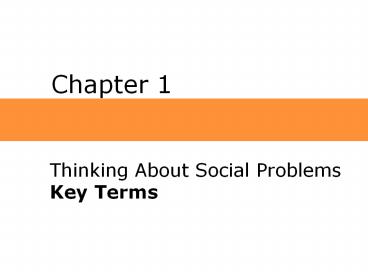Thinking About Social Problems Key Terms - PowerPoint PPT Presentation
1 / 20
Title:
Thinking About Social Problems Key Terms
Description:
Chapter 1 Thinking About Social Problems Key Terms objective element Refers to the existence of a social condition. subjective element The belief that a particular ... – PowerPoint PPT presentation
Number of Views:184
Avg rating:3.0/5.0
Title: Thinking About Social Problems Key Terms
1
Chapter 1
- Thinking About Social Problems Key Terms
2
- objective elementRefers to the existence of a
social condition. - subjective elementThe belief that a particular
social condition is harmful to society.
3
- social problemA social condition that a segment
of society views as harmful to members of society
and in need of remedy. - institutionEstablished and enduring patterns of
social relationships (family, religion, politics,
economics, and education).
4
- social groupTwo or more people who have a common
identity, interact, and form a social
relationship. - primary groupSmall, intimate, and informal
groups.
5
- secondary groupLarge or small, task-oriented,
impersonal, and formal groups. - statusPositions within a social group.
6
- ascribed statusAssigned on the basis of factors
over which the individual has no control (e.g.
sex, race). - achieved statusAssigned on the basis of some
characteristic or behavior over which the
individual has some control (e.g. parent, college
graduate).
7
- master statusStatus that is considered the most
significant in a persons social identity. - rolesThe set of rights, obligations, and
expectations associated with a status.
8
- beliefsDefinitions and explanations about what
is assumed to be true. - valuesSocial agreements about what is considered
good and bad, right and wrong, desirable and
undesirable.
9
- normsSocially defined rules of behavior.
- folkwaysThe customs and manners of society.
10
- lawsFormalized norms that are backed by a
political authority. - moresNorms that have a moral basis.
11
- sanctionsConsequences for conforming to or
violating norms. - symbolLanguage, gestures, and objects whose
meaning is commonly understood by the members of
a society.
12
- sociological imaginationThe ability to see the
connections between our personal lives and the
social world in which we live. - latent functionConsequences that are unintended
and often hidden.
13
- manifest functionIntended and recognized
conflict perspective. - anomieNorms that are weak, conflicting, or
unclear.
14
- alienationPowerlessness and meaningless in
peoples lives. - macro sociologyLooks at the "big picture" of
society and suggests how social problems are
affected at the institutional level.
15
- micro sociologyConcerned with the social
psychological dynamics of individuals interacting
in small groups. - labeling theoryIf a social condition or group is
viewed as problematic if it is labeled as such.
16
- variableAny measurable event, characteristic, or
property that varies or is subject to change.
Researchers must operationally define the
variables they study.
17
- operational definitionSpecifies how a variable
is to be measured. - hypothesisA prediction or educated guess about
how one variable relates to another variable.
18
- dependent variableThe variable the researcher
wants to explain. - independent variableThe variable that is
expected to explain change in the dependent
variable.
19
- experimentInvolve manipulating an independent
variable to determine how it affects the
dependent variable. - field researchInvolves observing and studying
social behavior in settings in which it occurs
naturally.
20
- survey researchInterviews, questionnaires, and
talking computers that elicit information from
respondents through questions (important to have
representative sample). - sampleA portion of the population, selected to
be representative so the information from the
sample can be generalized to a larger population.

